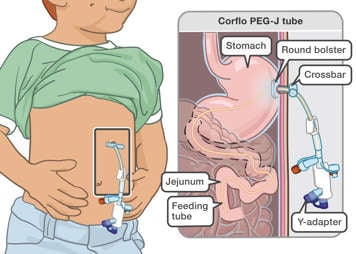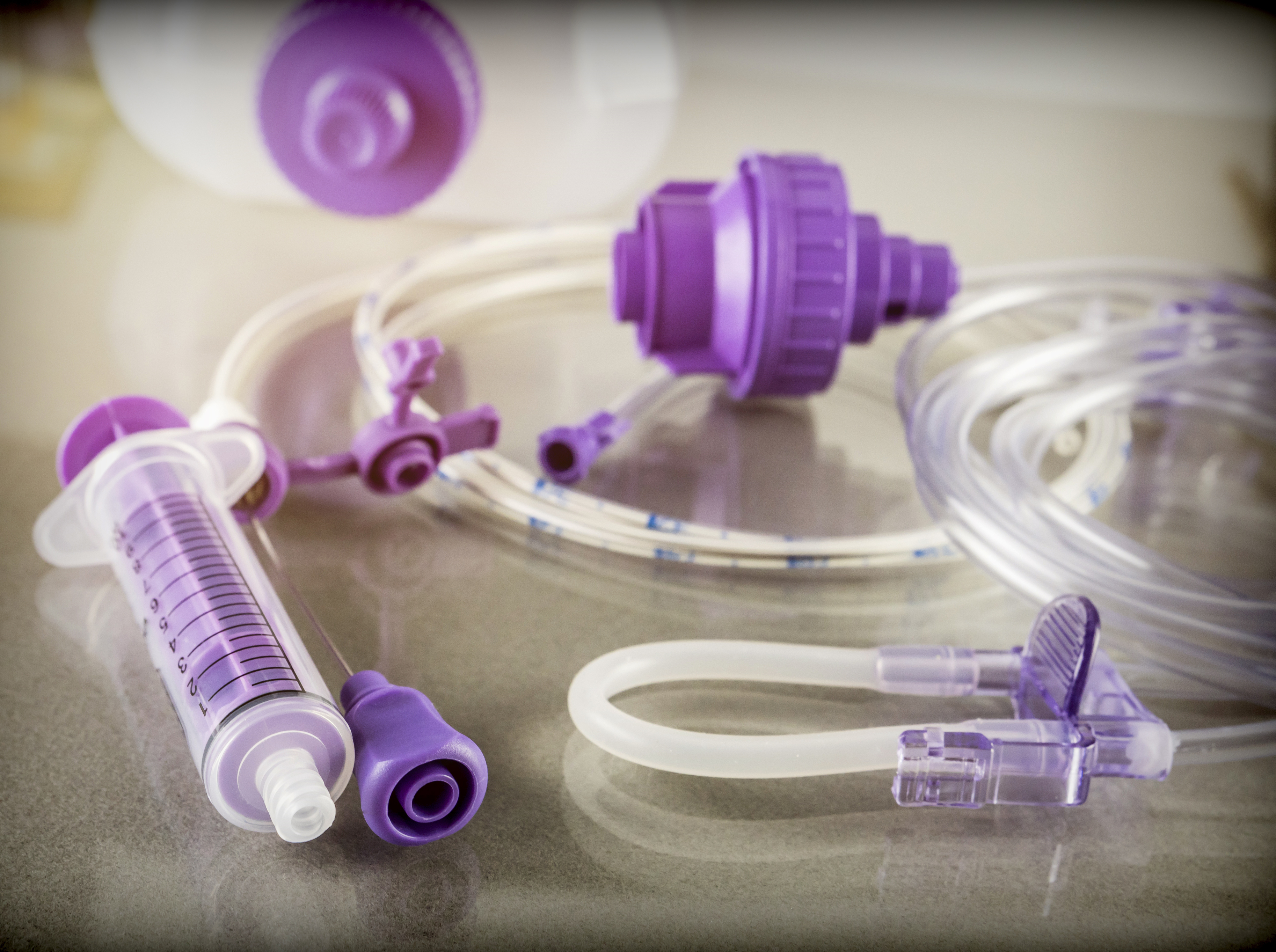A Corflo PEG J tube is a type of feeding tube that provides fluids, nutrition, and medication directly into the small intestine (jejunum). The Corflo PEG J tube is made up of two separate tubes: a Corflo PEG tube (a type of G tube) and a Silastic (silicon rubber) J tube. The Silastic tube is threaded through the Corflo PEG tube, into the jejunum.
| The SickKids G-Tube Feeding Program has developed a one page guide to help you quickly troubleshoot any issues with your child's feeding tube: G-Tube Feeding Program Family One Pager |
Inserting the Corflo PEG J tube

Corflo PEG tube insertion — G tube
The Corflo PEG tube is placed by an interventional radiologist using image guidance.
The interventional radiologist will create an opening in your child's tummy (abdomen) called a stoma. The tunnel from the outside of the body into the stomach is called the tract.
The Corflo PEG tube will be placed through the mouth, into the stomach and out through the stoma. There is a round bolster on the inside of the stomach that helps prevent the tube from being pulled out. A T-bar/crossbar fixation device on the outside of the stomach helps prevent the tube from moving too far into the stomach.

Silastic tube insertion — J tube
A Silastic tube is then used as a J tube. It is advanced through the Corflo PEG tube to access the jejunum. The tube passes through the Corflo PEG tube and continues through the stomach, duodenum and the first part of the small intestine. The tip of the Silastic J tube ends in the first part of the small intestine, called the jejunum.
Together, the Corflo PEG tube and the Silastic J tube make up the Corflo PEG J tube.
Caring for the Corflo PEG J tube

Your child will not need a dressing over the stoma after the insertion of a Corflo PEG J Tube. However, the interventional radiologist may apply a small gauze on the site, if they think it is necessary. If there is no leakage or discharge from the stoma, the gauze can be removed.
Follow these instructions to care for your child’s Corflo PEG J tube:
- Wash the stoma with soap and water daily, beginning 24 hours after insertion.
- Your child may not take baths during the first 48 hours after tube insertion.
- Your child’s tube can be secured to their abdomen with tape. This prevents the tube from moving around and pulling. If you tape the tube, it is important to change the position daily so that there is not too much pressure in one spot. For the first two weeks after insertion, do not adjust the crossbar. Contact the G tube specialist (at SickKids, this is the G Tube Resource Nurse) if you have concerns about the placement of the crossbar.
- After two weeks, the crossbar can be adjusted to sit at the stoma. If your child is still in hospital, a nurse can help you adjust the device. If your child is at home, follow the instructions below; call your G tube specialist if you are still unsure.
- The Silastic J tube is secured to the Corflo PEG tube with a securement device to prevent it from moving in and out of the Corflo PEG tube. The device is often called the “white securement device” or “Bel clamp”.
- Do not bend or manipulate the Silastic tube to block it, instead use the clamp.
- Your child may participate in their regular activities if they are feeling well and not experiencing severe pain or discomfort.
- For any tube or stoma issues, including infection, granulation tissue and leakage, call your G tube specialist.
Outflow of gastric (stomach) content into the Corflo PEG tube can be flushed with 5 mL of water once daily using the gastric port. Ask your child’s health-care team if your child can tolerate flushes into the stomach before doing this. You can also vent through the gastric port.
How to adjust the crossbar
The crossbar should sit close to your child’s stoma but it should not be too tight or too loose. Parents or caregivers can adjust the crossbar after the Corflo PEG J tube has been in place for more than two weeks. To adjust the fit of the crossbar, gently slide the round piece above the crossbar and the crossbar itself up or down the tube. Do not pull on the tube as this can lead to it being accidently pulled out of the tract and stoma.
What to do if your child's tube is accidentally pulled out
If the Corflo PEG tube is accidentally pulled out
Although it is very unlikely, your child's Corflo PEG tube may be accidentally pulled out. To learn what to do if your child's G tube is completely accidentally pulled out, please see the article What to do if your child's feeding tube is pulled out.
If the tube is only pulled out part way, the bolster on the end of the tube may become stuck in the tract. If this has happened, you may notice the following.
- significant pain to the G tube area
- a visible hard plastic bulge (the bolster) that does not go away when you move the tube
- you may be able to feel a hard bulge (the bolster) in the tract or stoma
- formula leaking from the stoma
If you are concerned that the tube has been partially pulled out and the bolster is stuck, call your G tube specialist right away. On the weekend/after hours, go to the Emergency Department.
If the Silastic J tube is accidentally pulled out
While the white securement device, or Bel clamp, is used to keep the J tube in place, it is possible that the tube may move or be pulled out.
If your child’s Silastic J tube looks longer than normal, it may have moved out of position.
If it is pulled out and your child is not tolerating feeds and experiencing pain, do not push the Silastic J tube back into the Corflo PEG tube and do not use the tube for feeding. Contact your child’s G tube specialist immediately or take your child to the Emergency Department after hours. Your child will need to have the tube placement checked and replaced by an interventional radiologist.
If your child’s Silastic J tube is pulled out less than 5 cm, you may continue to use the tube for feeding. If your child starts to experience any of the symptoms below, contact the G tube specialist or take your child to the Emergency Department after hours.
If the Silastic J tube has moved into the stomach
If the Silastic J tube has moved out of the small intestine and into the stomach, the Silastic J tube may be the same length as normal or longer than normal. Your child may experience:
- increased vomiting
- vomiting formula
- gagging and retching
- abdominal discomfort or pain
- bloated stomach
- diarrhea
The position of the tip of the Silastic J tube will need to be confirmed by an interventional radiologist using image guidance. Do not use the tube for feeding until the tube position is confirmed.
Intussusception
Intussusception may occur around the Silastic J tube. Intussusception refers to when one part of the small bowel slides into the next part. This may lead to a bowel obstruction at the tip of the Silastic J tube. Large GJ tubes and/or normal movements of the bowels may cause intussusception.
A child with intussusception will experience:
- discomfort and feeding intolerance (vomiting when fed)
- vomiting bile (green fluid)
- diarrhea or blood in the stool
If your child’s tube has intussuscepted, contact your G tube specialist during business hours. After hours, on weekends or on holidays, take your child to the Emergency Department.
Replacing the Silastic J tube
If your child’s Silastic J tube is accidentally pulled out or broken, it can be replaced with a new Silastic J tube under image guidance. A general anesthetic is not needed to replace the Silastic J tube.
Contact the G tube specialist to replace the dislodged, broken or blocked tube, or to exchange it for a low-profile GJ tube.
Your child’s Corflo PEG J tube can be exchanged for a low-profile GJ tube as early as three months after the primary insertion date. A booking with the interventional radiology team will be made to coordinate this exchange.
When to seek medical attention
Contact your child’s G tube specialist if you notice any of the following signs and symptoms:
- Your child’s stoma site appears infected with redness, swelling and odorous discharge.
- There is granulation tissue at the stoma, which is pink to bright red, bloody, raw, moist, oozing yellow sticky discharge and/or painful.
- The stoma site is leaking intestinal or stomach contents and/or formula.
- The tube appears to be damaged, broken or dislodged, but you can still use the tube.
Go to the nearest Emergency Department if you notice any of the following signs and symptoms:
- Your child experiences abdominal pain, distension, discomfort, vomiting and/or other signs of feeding intolerance.
- Your child has signs of respiratory distress (i.e., higher breathing rate or difficulty breathing).
- The tube appears to be damaged, broken or dislodged, and you cannot use the tube.
At SickKids
G Tube Resource Nurse contact info
Phone 416-813-7177
Email: g.tubenurse@sickkids.ca
On weekend/afterhours, your child may need to come to the Emergency Department for an alternate method of feed/fluids/medications administration.
